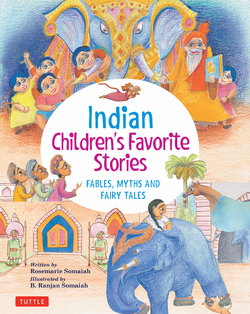Читать книгу Indian Children's Favorite Stories - Rosemarie Somaiah - Страница 6
На сайте Литреса книга снята с продажи.
ОглавлениеIndia is a large, beautiful and very complex land with over a billion people. Its folklore, legends and mythology are a richly woven tapestry. Individual stories, like threads, weave in and out and shimmer or shine brilliantly, but it is often difficult to know where they begin and end. What is more, their colors seem to change with the light! As these stories evolved over hundreds of years over a very large geographical area, and have been told orally for generations, there are a myriad of versions—some strange, some funny—but all completely fascinating.
Some stories in this book are based on folklore and the common man. The motifs remain the same though the details may change. The wise man, the foolish man, the trickster and the clown—the popularity of these characters is undiminished.
Other stories have religious connotations. While these stories can hold their own on any bookshelf of myths and legends, it is important to remember that they form the core of a way of life that continues to this day.
All the major religions have followers in India. However, the majority of Indians are Hindus. To attempt to explain the rich philosophy of Hindusim is difficult. Still, one must begin somewhere.
Most Hindus believe in the concept of one Supreme Being, who in stories is given different names and attributes, resulting in the creation of characters called devas. In English, devas are loosely referred to as “gods” and “goddesses.”
The three most popular male representations of the Supreme Being in Hindu mythology are Brahma, the Creator; Vishnu, the Preserver; and Shiva, the Destroyer. However, Shiva embodies many contrasts, for he can conquer death as well as destroy. Many of the heroes in myths and legends, such as Rama and Krishna, are human incarnations of Vishnu, the Preserver.
The female counterparts to these representatives are Saraswati, Goddess of Learning; Lakshmi, Goddess of Light; and Parvati, who, like Shiva, is full of contrasts. She may be seen either as a perfect wife or the fearsome goddess Kali.
The antagonists or villains in these stories are the demons called rakshasas, or asuras, who usually represent evil.
Both the devas and rakshasas, or asuras, can have magic powers, including the power to grant blessings or to curse. They can change their shapes and each of them usually has special skills.
On occasion, the devas, usually representatives of good, may make mistakes and the evil rakshasas or asuras can be heroic. When this happens, the deva may temporarily lose some power, and the rakshasa may gain some. In this way, the universe maintains a fragile balance.
Folktales, legends and mythology alike, these stories truly come to life again when they are retold or passed on from generation to generation as they have been for thousands of years.
